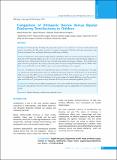Please use this identifier to cite or link to this item:
https://hdl.handle.net/20.500.14356/1437Full metadata record
| DC Field | Value | Language |
|---|---|---|
| dc.contributor.author | Sah, Mukesh Kumar | - |
| dc.contributor.author | Neupane, Yogesh | - |
| dc.contributor.author | Guragain, Rajendra Prasad | - |
| dc.date.accessioned | 2023-05-11T07:00:41Z | - |
| dc.date.available | 2023-05-11T07:00:41Z | - |
| dc.date.issued | 2019 | - |
| dc.identifier.citation | SahM. K., NeupaneY., & GuragainR. P. (2019). Comparison of Ultrasonic Device Versus Bipolar Diathermy Tonsillectomy in Children. Journal of Nepal Health Research Council, 17(01), 71-75. https://doi.org/10.33314/jnhrc.v17i01.1751 | en_US |
| dc.identifier.issn | Print ISSN: 1727-5482; Online ISSN: 1999-6217 | - |
| dc.identifier.uri | http://103.69.126.140:8080/handle/20.500.14356/1437 | - |
| dc.description | Original Article | en_US |
| dc.description.abstract | Abstract Background: Intraoperative bleeding and postoperative pain are two commonest concerns for both patient and surgeon in tonsillectomy. This study was aimed to compare intraoperative blood loss and early postoperative pain between ultrasonic device and bipolar diathermy tonsillectomy in children. Methods: Prospective, interventional, single blinded, comparative study was carried out from September 2016 to September 2017 including children up to age 15 years who underwent tonsillectomy either by bipolar diathermy or ultrasonic device. Intraoperative blood loss was recorded using standard sized gauge technique. Post-tonsillectomy pain on first five postoperative days (early postoperative pain) was assessed using Visual analog scale for children older than 5 years and FLACC score for children up to 5 years respectively.Means were compared. Results: 38 children (76 tonsils) were included in the study out of which 31 were boys (62 tonsils) and 7 were girls (14 tonsils). The mean intraoperative blood loss in ultrasonic dissection group was 13.94 ml and 13.91 ml in bipolar diathermy group. This difference was not statistically significant (p=0.974). Post-operative pain on 1st, 2nd, 3rd and 4th days were significantly less (p<0.05) in ultrasonic device group compared to bipolar diathermy group. Post-operative pain was less also on 5th post-operative day in ultrasonic device but was not statistically significant (p=0.172). Conclusions: Tonsillectomy in children using ultrasonic device did not differ from bipolar diathermy tonsillectomy in respect to intraoperative blood loss. However, early postoperative pain was significantly lower in ultrasonic device group. Keywords: Bipolar diathermy; tonsillectomy; ultrasonic device. | en_US |
| dc.language.iso | en | en_US |
| dc.publisher | Nepal Health Research Council | en_US |
| dc.relation.ispartofseries | Jan-March, 2019;1751 | - |
| dc.subject | Bipolar diathermy | en_US |
| dc.subject | Tonsillectomy | en_US |
| dc.subject | Ultrasonic device | en_US |
| dc.title | Comparison of Ultrasonic Device Versus Bipolar Diathermy Tonsillectomy in Children | en_US |
| dc.type | Journal Article | en_US |
| local.journal.category | Original Article | - |
| Appears in Collections: | Vol. 17 No. 1 Issue 42 Jan - Mar 2019 | |
Files in This Item:
| File | Description | Size | Format | |
|---|---|---|---|---|
| 1751-Manuscript-9273-2-10-20190430.pdf | Fulltext Download | 247.09 kB | Adobe PDF |  View/Open |
Items in DSpace are protected by copyright, with all rights reserved, unless otherwise indicated.
